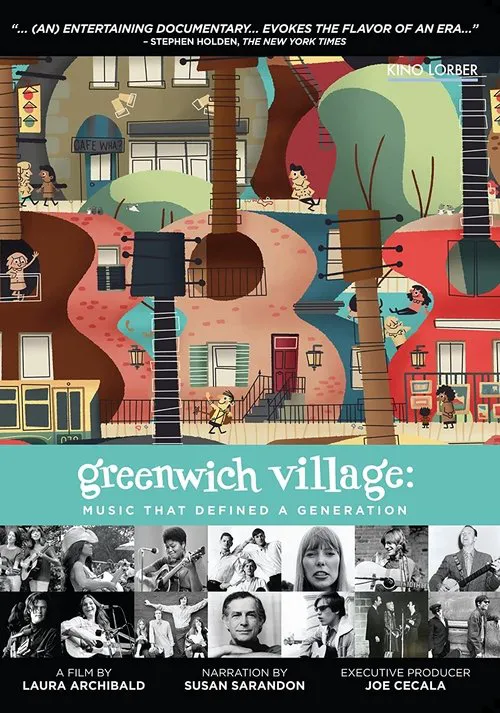Unveiling the Soul of an Era: The Story Behind “Greenwich Village: Music That Defined a Generation”
Greenwich Village in the 1960s and early 1970s was more than just a place on a map; it was an epicenter, a crucible where artistic expression, social defiance, and groundbreaking music converged to shape a generation. The documentary film, “Greenwich Village: Music That Defined a Generation,” isn’t just a nostalgic look back; it’s a meticulously crafted journey into the very heart of this vibrant cultural explosion, revealing the untold stories and enduring legacies of the artists who powered it.
Journey into the Birthplace of Counterculture
The film’s ambition was clear from the outset: to capture the raw, unbridled spirit of a musical movement deeply intertwined with a seismic shift in society. Imagine a time when the air in narrow Village streets crackled with electric anticipation, where acoustic guitars and poignant voices became instruments of change. “Greenwich Village: Music That Defined a Generation” doesn’t just present a collection of songs; it presents a vivid tapestry woven from the lives, struggles, and triumphs of the era’s iconic singer-songwriters.

Behind the scenes of bringing this narrative to life was a deep dive into rich historical archives. Filmmakers painstakingly sifted through rare footage and unearthed forgotten interviews, piecing together a mosaic that feels both intimate and grand in its scope. The challenge was not just to chronicle who was there, but why they were there, and how their music resonated so profoundly.
The Voices That Shaped a Sound
At the core of the film are the legendary figures who walked the Village’s hallowed sidewalks. From Bob Dylan, whose incendiary folk anthems like “Blowin’ in the Wind” became a rallying cry against the status quo, to Joni Mitchell, whose introspective songwriting gifted the world “Both Sides Now” – each artist is presented not just as a musician, but as a product of and a contributor to the Village’s unique ecosystem.
The film delves into their individual journeys, showing how talents like Judy Collins, with her haunting beauty and distinctive interpretations, and James Taylor, with his gentle yet profound melodies, found their voice amidst shared creative energies. Even the larger-than-life presence of David Crosby, whose profound insights into society resonated through songs like “Guinnevere,” is woven into this rich narrative. The brilliance of the film lies in how it connects these individual narratives, illustrating how each artist, in their own way, was a testament to the Village’s enduring spirit of boundless creativity.
More Than a Scene: A Community and Incubator
What makes this documentary truly come alive is its focus on the Village not just as a backdrop, but as an active character. The historical gatherings at legendary venues like Gerde’s Folk City and Café Wha? are portrayed as more than mere performance spaces. They were incubators where ideas fermented, collaborations blossomed, and a unique sense of camaraderie flourished. Think of it as a living organism, constantly evolving, where musicians and audiences alike were part of the same creative revolution.
Filmmakers utilized intimate interviews with surviving era participants and rare archival footage to transport viewers directly into these hallowed halls. This isn’t just a story told from a distance; it feels like an invitation to witness history being made, revealing the mutual respect and shared passion that defined the era’s artistic community.

Music as a Reflection of Tumultuous Times
Crucially, “Greenwich Village: Music That Defined a Generation” understands that the music did not exist in a vacuum. The film expertly weaves in the era’s tumultuous social context – the Vietnam War, the Civil Rights Movement, the cultural upheavals that were reshaping America. The songs became soundtracks to these pivotal moments, reflecting the collective hopes, fears, and aspirations of a generation grappling with profound change.
This careful contextualization adds immense depth to the narrative, showcasing how these singer-songwriters, often associated solely with the Village scene, transcended geographical boundaries and genre labels to speak to a global audience. Their art wasn’t just entertainment; it was a potent form of commentary, protest, and celebration.
An Enduring Legacy
As the film concludes, it leaves viewers not with a sense of nostalgia, but with a powerful reminder of music’s enduring power. “Greenwich Village: Music That Defined a Generation” is a testament to how art can inspire, heal, and unite. The legacy of these artists and the vibrant creative spirit of the Village continue to resonate—a powerful reminder of music’s transformative potential and its lasting impact on our world. It ensures that the story of this singular time and place, and the sounds that sprung from it, will continue to inspire generations to come.